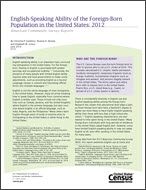English-Speaking Ability of the Foreign-Born Population in the United States: 2012
English-Speaking Ability of the Foreign-Born Population in the United States: 2012
Introduction
English-speaking ability is an important topic surrounding immigration in the United States. For the foreign born, fluency in English is associated with greater earnings and occupational mobility.1,2 Conversely, the presence of many people with limited English ability requires state and local governments to make costly adjustments, such as providing English as a Second Language classes in schools and translating official forms into multiple languages.3,4,5
English is not the native language of most immigrants in the United States. However, many do arrive knowing how to speak English, especially from countries where English is widely used. These include not only countries such as Canada, Jamaica, and the United Kingdom, where English is the primary language, but also countries where English is an official language, such as India, Nigeria, and the Philippines.6 Many others learn English through years of study or practice prior to immigrating to the United States or while living in the United States.
There is considerable diversity in English use and English-speaking ability among the foreign born. Research has shown that educational level plays a part, as those foreign born who have a bachelor’s degree or higher are more likely to have higher English-speaking ability than those with less than a high school education.7,8 English-speaking characteristics are also related to time spent living in the United States.9 Many foreign-born individuals with long periods of residence in the United States speak English well. However, some have limited English-speaking ability or may not speak English at all, even after residing in the United States for many years.
Using data from the 2012 American Community Survey (ACS), this report examines English use at home and English-speaking ability among the foreign born, focusing on the relationships between English-speaking ability and place of birth, level of education, and years spent living in the United States. While previous American Community Survey reports include both the native and foreign born, this report will focus on English language use and English-speaking ability among only the foreign-born population.10,11
__________
1 Jeanne Batalova and Michael Fix. “A Profile of Limited English Proficient Adult Immigrants,” Peabody Journal of Education, 2010. 85(4): 511–534.
2 Sherrie A. Kossoudji. “English Language Ability and the Labor Market Opportunities of Hispanic and East Asian Immigrant Men,” Journal of Labor Economics, 1988. 6(2): 205–228.
3 Arlene Ortiz and Shirley Woika. “Teaching to the Letter of the Law,” Language Magazine, July 2013. Accessed April 29, 2014, <languagemagazine.com/?page_id=6787>.
4 Bruce A. Evans and Nancy H. Hornberger. “No Child Left Behind: Repealing and Unpeeling Federal Language Education Policy in the United States,” Language Policy, 2005, 4: 87–106.
5 Fernanda Santos. “Mayor Orders New York to Expand Language Help,” New York Times, July 23, 2008. Accessed April 29, 2014, <www.nytimes.com/2008/07/23/nyregion/23translate.html>.
6 Central Intelligence Agency. The World Factbook 2013-14. Field Listing: Languages. Washington, DC. 2013. Accessed April 29, 2014, <www.cia.gov/library/publications/the-world-factbook/fields/print_2098.html>.
7 Julia Beckhusen, Raymond J.G.M. Florax, Thomas de Graaff, Jacques Poot, and Brigitte Waldorf. “Living and Working in Ethnic Enclaves: Language Proficiency of Immigrants in U.S. Metropolitan Areas,” Papers in Regional Science, 2013. 92(2): 305–328.
8 Edith K. McArthur. Language Characteristics and Schooling in the United States, A Changing Picture: 1979 and 1989. National Center for Education Statistics. Washington, DC: U.S. Government Printing Office. 1993.
9 Calvin Veltman. “Modelling the Language Shift Process of Hispanic Immigrants,” International Migration Review, 1988. 22(4): 545–562.
10 Camille Ryan. Language Use in the United States: 2011. American Community Survey Reports, ACS-22. U.S. Census Bureau, Washington, DC. 2013.
11 Hyon B. Shin and Robert A. Kominski. Language Use in the United States: 2007. American Community Survey Reports, ACS-12. U.S. Census Bureau, Washington, DC. 2010.
Others in Series
Publication
Publication
Publication






